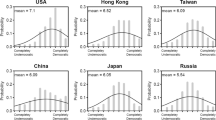Abstract
Many spatial models of voting suggest that citizens are more likely to abstain when they feel indifferent toward the candidates or alienated from them. In presidential elections, previous research offers evidence that alienation and indifference affect individuals' probabilities of voting. We find evidence that indifference and alienation also affect the decision to vote in midterm Senate elections, a context not previously explored. These individual-level effects imply that candidates' ideological locations should influence aggregate turnout by affecting the proportions of citizens who feel indifferent toward or alienated from the candidates. Our aggregate-level analysis supports this (at least in contests featuring two previous and/or future members of Congress). Our findings underscore the importance of the electoral context for understanding citizen behavior and suggest that elections featuring at least one centrist candidate may be normatively appealing since they stimulate participation.
Similar content being viewed by others
REFERENCES
Abramowitz, Alan I., and Segal, Jeffrey A. (1992). Senate Elections. Ann Arbor: University of Michigan Press.
Adams, James, Dow, Jay, and Merrill, Samuel III (2002). The political consequences of abstention due to alienation and indifference: applications to presidential elections. Revised version of paper presented at the Annual Meeting of the American Political Science Association, San Francisco, CA, August 30–September 2, 2001.
Alvarez, R. Michael (1997). Information and Elections. Ann Arbor: University of Michigan Press.
Belli, F. Robert, Traugott, Michael W., Young, Margaret, and McGonagle, Katherina A. (1999). Reducing vote overreporting in surveys. Public Opinion Quarterly 63: 90-108.
Brody, Richard A., and Page, Benjamin I. (1973). Indifference, alienation, and rational decisions. Public Choice 15: 1-17.
Burden, Barry C. (2000). Voter turnout in the National Election Studies. Political Analysis 8: 389-390.
Davis, Otto A., Hinich, Melvin J., and Ordeshook, Peter C. (1970). An expository development of a mathematical model of the electoral process. American Political Science Review 64: 426-448.
Deufel, Benjamin J., and Kedar, Orit (2003). Race and turnout in U.S. elections: exposing hidden effects. Revised version of paper presented at the Annual Meeting of the Midwest Political Science Association, Chicago, IL, April 19–22, 2001.
Downs, Anthony (1957). An Economic Theory of Democracy. New York: Harper Collins.
Enelow, James M., and Hinich, Melvin J. (1984). The Spatial Theory of Voting: An Introduction. New York: Cambridge University Press.
Hill, Kim Quaile, and Hurley, Patricia A. (1984). Nonvoters in voters' clothing: the impact of voting behavior misreporting on voting behavior research. Social Science Quarterly 65: 199-206.
Hinich, Melvin J., Ledyard, John O., and Ordeshook, Peter C. (1972). Nonvoting and the existence of equilibrium under majority rule. Journal of Economic Theory 4: 144-153.
Hinich, Melvin J., and Munger, Michael (1994). Ideology and the Theory of Political Choice. Ann Arbor: University of Michigan Press.
Hinich, Melvin J., and Ordeshook, Peter C. (1969). Abstentions and equilibrium in the electoral process. Public Choice 7: 81-106.
Katosh, John P., and Traugott, Michael W. (1981). The consequences of validated and self-reported voting measures. Public Opinion Quarterly 45: 519-535.
Macdonald, Stuart Elaine, and Rabinowitz, George (1997). Comment on Merrill and Grofman on "correcting" for rationalization. Journal of Theoretical Politics 9: 49-55.
Ordeshook, Peter C. (1970). Extensions to a model of the electoral process and implications for the theory of responsible parties. Midwest Journal of Political Science 14: 43-70.
Poole, Keith T. (1998). Recovering a basic space from a set of issue scales. American Journal of Political Science 42: 954-993.
Presser, Stanley, and Traugott, Michael (1992). Little white lies and social science models: correlated response errors in a panel study of voting. Public Opinion Quarterly 56: 77-86.
Rabinowitz, George, Macdonald, Stuart Elaine, and Listhaug, Ola (1991). New players in an old game: party strategy in multiparty systems. Comparative Political Studies 24: 147-185.
Ragsdale, Lynn, and Rusk, Jerold G. (1993). Who are nonvoters? Profiles from the 1990 Senate elections. American Journal of Political Science 37: 721-746.
Riker, William H., and Ordeshook, Peter C. (1968). A theory of the calculus of voting. American Political Science Review 62: 25-42.
Rosenstone, Steven J., and Hansen, John Mark (1993). Mobilization, Participation, and Democracy in America. New York: Macmillan.
Sigelman, Lee (1982). The nonvoting voter in voter research. American Journal of Political Science 26: 47-56.
Silver, Brian D., Anderson, Barbara A., and Abramson, Paul R. (1986). Who overreports voting? American Political Science Review 80: 613-624.
Wolfinger, Raymond E., and Rosenstone, Steven J. (1980). Who Votes? New Haven, CT: Yale University Press.
Zipp, John F. (1985). Perceived representativeness and voting: an assessment of the impact of "choices" vs. "echoes." American Political Science Review 79: 50-61.
Author information
Authors and Affiliations
Rights and permissions
About this article
Cite this article
Plane, D.L., Gershtenson, J. Candidates' Ideological Locations, Abstention, and Turnout in U.S. Midterm Senate Elections. Political Behavior 26, 69–93 (2004). https://doi.org/10.1023/B:POBE.0000022344.05382.b4
Issue Date:
DOI: https://doi.org/10.1023/B:POBE.0000022344.05382.b4




